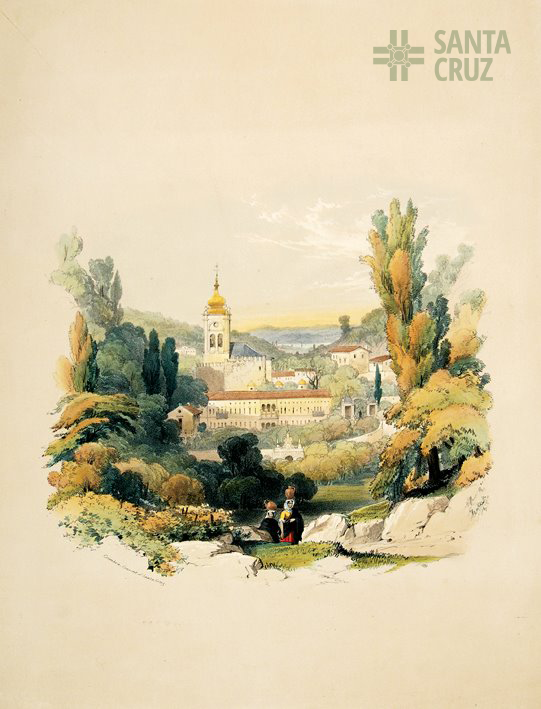The Monastery of Santa Cruz of Coimbra, national see of the Canons Regular of Saint Augustine, was one of the main Portuguese religious houses. It was founded in the 1131 under the patronage of D. Afonso Henriques, the first King of Portugal, who made Coimbra his capital.
During the first half of the sixteenth century the monastery would be twice renovated. D. Manuel had both the Romanesque church and cloister destroyed, ordering their reconstruction under the late Gothic-Manueline flavor. He raised new tombs for the first two Portuguese kings in the church’s new main chapel.
A few years later, D. João III added two new cloisters (one with the Manga fountain), a new dormitory, a library and a dining hall, making Santa Cruz the first Portuguese renaissance monastery. It was from the reformed monastery that Rua de Santa Sophia (the Street of Holy Knowledge) was launched for the colleges of the newly installed university. Among the later monastic additions are the seventeenth-century vestry and the Baroque sanctuary.
The extinction of religious orders in 1834 led to the loss of a significant part of this architectural heritage. The rehabilitation of Plaza 8 de Maio, by the architect Fernando Távora in 1997, restored dignity to the church, classified, since 2003, as “National Pantheon”.

Chronology
1131 (June 28th): first stone of the monastery is laid down by the twelve founders between which are the archdeacon D. Telo and the schoolmaster D. João Peculiar.
1132 (February 24th): the life of the community begins – 72 monks under Prior D. Teotónio
Cª.1150: consecration of the head chapel; the construction of both church and monastic dependencies is advancing.
1163: Bull of Pope Alexander III recognizing the autonomy of the monastery from the See of Coimbra.
1185 (December 6th): D. Afonso Henriques, first king of Portugal, dies.
1229 (January 7th): consecration of the Church in the presence of Papal Legate John of Abbeville, Bishop of Sabina.
Romanesque church had 3 side chapels on either side of the nave: St. Peter, St. Vident and St. Anthony on the gospel side; St. Michael, St. Andrew and St. James (S. Tiago) on the side of the Epistle.
1441-1459: the Chapel of the Martyrs of Morocco is established by reforming the side chapels of the nave, on the side of the epistle (priory of D. Gomes Eanes).
1502: King Manuel visits the Monastery of Santa Cruz on his way to Santiago de Compostela.
1505: Prior D. João de Noronha dies.
Pope Julius II hands over the Priory of Santa Cruz to his nephew Galiotto della Rovere.
The demolition works of the Romanesque church begin, ordered by King Manuel.
1507: Julius II gives up the idea of handing the priory to his nephew. Papal brief, whereby the Kings of Portugal are authorized to name the priors of the monastery.
1507-16: Priory of D. Pedro Gavião, Bishop of Guarda (the first Prior of royal appointment)
1507-13: Diogo de Boytac rebuilds the church’s new head-chapel
The stalls are executed by Master Machim
Diogo de Boytac also builds the new chapter house.
1513 (January 24th): contract with Diogo de Boytac for the reconstruction of the church’s nave.
1517-25: Marcos Pires builds the Silence Cloister and the St. Michael and Jesus chapels.
Marcos Pires reforms the original refectory (in the cloister’s east wing) and makes the fountain of Paio Guterres.
Marcos Pires finishes the upper decoration of the church facade (1518)
1518-22: the tombs of the kings in the head chapel are done (by Diogo de Castilho under a probable design by his brother João de Castilho; recumbent statues by Nicholas Chanterene).
1521: church pulpit, by Nicholas Chanterene.
1521 (December 13th): King Manuel dies. His son becomes John III.
1522: retables of the Silence Cloister, by Nicholas Chanterene.
1522-25: the portal of the facade of the church is made (project of João de Castilho, execution of Diogo de Castilho and Nicholas Chanterene)
1522-30: the altarpiece of the chancel is placed (paintings by Cristóvão de Figueiredo)
1527: John III spends six months in Coimbra, from July 10th.
1527 (October 13th): Hyeronomite Friar Brás de Barros becomes Prior of Santa Cruz and Reformer of the Canons Regular of St. Augustine.
1528 (March 5th): contract with Diogo de Castilho for the construction of a new dormitory and refectory.
1529: the former feminine convent of S. João das Donas is extinct.
1530: the monastery library and porter’s cloister are finished.
Construction of new parish church of S. João.
The Montarroio tower becomes the monastic bell tower.
1530 (September 26th): carpentry contract for the new dormitory.
1530 (October 7th): contract for the Last Supper, between the monastery and the sculptor Hodart. The new refectory is now complete.
1531 (May 15th): Diogo de Castilho appointed master of stoneworks of Santa Cruz, replacing Marcos Pires, who died 10 years earlier.
1531: construction of the Santa Cruz church’s high choir (vault by Diogo de Castilho, archway by Jean de Rouen).
Placement of three sculptures by Jean de Rouen above the church portal and under the new choir window.
Master Machim’s stalls are installed in the high choir, adjusted and amplified by Francisco Lorete.
The king’s tombs are transferred to the head chapel.
1532: arches of the side chapels of the church (Jean de Rouen).
1533 (September 7th): Friar Brás de Braga contracts with the masons Pero de Évora, Diogo Fernandes and Fernão Luís the construction of the Manga fountain tanks (fountain designed by Jean de Rouen).
1534 (January 8th): Hodart receives money for concluding the Last Supper.
1535: Vasco Fernandes (Grão Vasco) paints the “Pentecost” for the chapel of the Holy Spirit.
1535 (February 26th): Friar Brás de Braga contracts with carpenter João Afonso works in the new classes for the studies (Santa Catarina classroom and others).
1535: the colleges of St. Augustine and St. John the Baptist are established inside the Monastery.
1537: John III transfers the University from Lisbon to Coimbra.
Faculties of Theology, Medicine and Arts installed at Santa Cruz.
Opening of Santa Sophia street
1538-39: allotment of the western front of Santa Sophia street for private buildings
1540: Descripçam e debuxo do Mosteyro de Santa Cruz de Coimbra, by D. Francisco de Mendanha.
1541: first university colleges settle on the Eastern front of Santa Sophia street
1544: all University Faculties are transferred to the Royal Palace uptown.
1545-46: extinction of the Grand-Priory of Santa Cruz. All revenue reverts to the University.
1547: the College of Arts is instituted.
1548: beginning of the construction of the College of Arts, on the Eastern front of Santa Sophia street.
1555: College of Arts is handed down to the Jesuits.
1565: the Jesuits transfer the College of Arts uptown, and sell the buildings to the Inquisition.
1582-88: the chapel of S. Teotónio (by Tomé Velho) was opened in the South wall of the chapter room.
Cª 1589: description of the monastery by Friar Jerónimo Roman.
1592: beginning of construction of the New College of St. Augustine College, or Sapiência College, on the slope over the Monastery of Santa Cruz.
1593-96: cloister of the New College (attributed to Philip Terzi)
1599-1602: the original dining room windows are replaced by the current rectangular windows (Prior D. Acúrcio of St. Augustine).
1600: the monks decide to replace the altarpiece of the monastic church by commissioning a new one from sculptor Gaspar Coelho (who died in 1605)
1610-12: paintings by Simão Rodrigues and Domingos Viera Serrão for the new altarpiece.
1618-21: extension of the main dormitory to the west, until reaching Largo de Sansão.
1622-24: the new vestry is built, designed by Baltasar Álvares
1627-30: triumphal arch of the chapel of S. Teotónio.
1630-33: tiles are laid in the monastic refectory.
1633-56: construction of the infirmary building, to the East of the monastery.
1638: central fountain of the Silence Cloister is placed.
1719-1724: new organ of the church, executed by the Spanish master organist Manuel Gomes Herrera.
1731 (November 9th): contract with Gaspar Ferreira for the construction of the Relics Chapel (or “Sanctuary”). The work was expected to take three years.
Mid-18th Century: rebuilding of the church doorway.
1788: completion of the new altarpiece, with insertion of a canvas by Pascoal Parente.
1796: drawing by José Carlos Magne registering the monastic façade.
1834: extinction of Religious Orders
1839: the Wheel of the Exposed is installed in the building of the old infirmary of the monastery (now Jaime Cortesão Secondary School).
1858: the Street of Coruche, now Visconde da Luz, was regularized in a Haussmann-type intervention.
1865 (July 6th): a Government ordinance cedes the refectory of the monastery for the headquarters of the Artists’ Association.
1866: sculptures of the Last Supper were already mutilated when the statue of King Fernando II was inaugurated in the former monastic refectory.
1876-79: construction of the City Hall building (design by Engineer Alexandre da Conceição) over the space of the former Porter’s Cloister (which was demolished).
1885: Municipality acquires the old Quinta de Santa Cruz to open a new avenue (actual Sá da Bandeira Avenue).
1907: Santa Cruz Monastery classified as a “National Monument”.
1917 (January 12th): fire in the monastic premises belonging to the Avelar Brotero Industrial School, on the western section of the Manga Fountain.
1922: inauguration of the Santa Cruz Café (design by Architect Jaime Inácio dos Santos).
1926 (January 2nd): a fire completely destroys the Post Office building, to the east of the Manga fountain.
1935 (January 3rd): collapse of the bell tower.
1935-40: rehabilitation intervention of the Manga Fountain and construction of the restaurant by DGEMN (National Monuments).
1939: inauguration of the Coimbra Central Post Office building, to the east of the Manga fountain. The building was begun five years before.
1950-54: construction of the CGD Bank building, designed by Architect Veloso Reis Camelo.
1972: intervention in the chapel of the Martyrs of Morocco.
1993-97: remodeling of Plaza 8th of May, designed by Architect Fernando Távora.
2000-2004: Construction of the new Municipal Market.
2003: Church of Santa Cruz becomes a National Pantheon.
